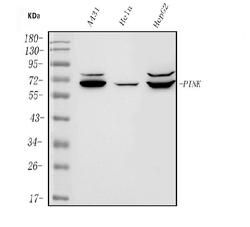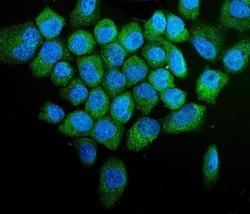Antibody data
- Antibody Data
- Antigen structure
- References [3]
- Comments [0]
- Validations
- Western blot [1]
Submit
Validation data
Reference
Comment
Report error
- Product number
- A00201-2 - Provider product page

- Provider
- Boster Biological Technology
- Product name
- Anti-PINK1 Antibody Picoband™
- Antibody type
- Polyclonal
- Description
- Rabbit IgG polyclonal antibody for PINK1 detection. Tested with WB, ICC/IF, FCM, Direct ELISA in Human.
- Reactivity
- Human
- Host
- Rabbit
- Vial size
- 100μg/vial
- Concentration
- Add 0.2ml of distilled water will yield a concentration of 500ug/ml.
- Storage
- At -20°C for one year. After reconstitution, at 4°C for one month. It can also be aliquoted and stored frozen at -20°C for a longer time. Avoid repeated freezing and thawing.
- Handling
- Add 0.2ml of distilled water will yield a concentration of 500ug/ml.
Submitted references Atmospheric fine particulate matter (PM(2.5)) induces pulmonary fibrosis by regulating different cell fates via autophagy.
Study on the neuroprotective effect of Zhimu-Huangbo extract on mitochondrial dysfunction in HT22 cells induced by D-galactose by promoting mitochondrial autophagy.
Robust intervention for oxidative stress-induced injury in periodontitis via controllably released nanoparticles that regulate the ROS-PINK1-Parkin pathway.
Liu B, Han Y, Ye Y, Wei X, Li G, Jiang W
The Science of the total environment 2024 May 1;923:171396
The Science of the total environment 2024 May 1;923:171396
Study on the neuroprotective effect of Zhimu-Huangbo extract on mitochondrial dysfunction in HT22 cells induced by D-galactose by promoting mitochondrial autophagy.
Xue A, Zhao D, Zhao C, Li X, Yang M, Zhao H, Zhao C, Lei X, Wu J, Zhang N
Journal of ethnopharmacology 2024 Jan 10;318(Pt B):117012
Journal of ethnopharmacology 2024 Jan 10;318(Pt B):117012
Robust intervention for oxidative stress-induced injury in periodontitis via controllably released nanoparticles that regulate the ROS-PINK1-Parkin pathway.
Li X, Zhao Y, Peng H, Gu D, Liu C, Ren S, Miao L
Frontiers in bioengineering and biotechnology 2022;10:1081977
Frontiers in bioengineering and biotechnology 2022;10:1081977
No comments: Submit comment
Supportive validation
- Submitted by
- Boster Biological Technology (provider)
- Main image

- Experimental details
- Western blot analysis of PINK1 using anti-PINK1 antibody (A00201-2). Electrophoresis was performed on a 5-20% SDS-PAGE gel at 70V (Stacking gel) / 90V (Resolving gel) for 2-3 hours. The sample well of each lane was loaded with 50ug of sample under reducing conditions. Lane 1: human A431 whole cell lysates, Lane 2: human HELA whole cell lysates, Lane 3: human HEPG2 whole cell lysates. After Electrophoresis, proteins were transferred to a Nitrocellulose membrane at 150mA for 50-90 minutes. Blocked the membrane with 5% Non-fat Milk/ TBS for 1.5 hour at RT. The membrane was incubated with rabbit anti-PINK1antigen affinity purified polyclonal antibody (Catalog # A00201-2) at 0.5 μg/mL overnight at 4°C, then washed with TBS-0.1%Tween 3 times with 5 minutes each and probed with a goat anti-rabbit IgG-HRP secondary antibody at a dilution of 1:5000 for 1.5 hour at RT. The signal is developed using an Enhanced Chemiluminescent detection (ECL) kit (Catalog # EK1002) with Tanon 5200 system. A specific band was detected for PINK1 at approximately 64KD. The expected band size for PINK1 is at 64KD.
- Additional image

 Explore
Explore Validate
Validate Learn
Learn Western blot
Western blot ELISA
ELISA